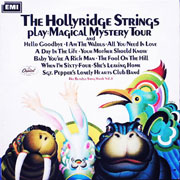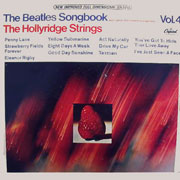Mort Garson
extract from Wikipedia
Mort Garson (20 July 1924 – 4 January 2008) who was born in Saint John, New Brunswick, Canada, was an electronic musician best known for his albums that predominantly feature Moog synthesizers.
Mort Garson studied music at Juilliard and worked as a
pianist and arranger before getting pulled into the Army near
the end of World War Two. He could carry out any or all of the
musical chores on any given session: composer, arranger,
orchestrator, conductor, and even pianist if that was required.
He conducted the "Love Strings" on Liberty Records, arranged for
the Lettermen on Capitol Records, provided background to
Laurence Harvey reading poetry on Atlantic Records, accompanied
Doris Day on Columbia and experimented with the Moog synthesizer
on A&M Records, and that's just the tip of the iceberg. With
lyricist Bob Hilliard, he wrote one of the great lounge hits of
the 1960s, "Our Day Will Come", a hit for Ruby & The Romantics
and more recently covered by K. D. Lang and Take 6 for the
soundtrack of the movie Shag.
Garson
spent the mid-1960s on a rapid succession of accompaniment jobs:
two Doris Day albums (Sentimental Journey and Songs for Latin
Lovers), Mel Tormé's great Right Now! album of contemporary
covers like "Secret Agent Man," Glenn Yarborough's highly
successful cover of Rod McKuen songs, The Lonely Things, and
Glen Campbell's even more successful "By the Time I Get to
Phoenix." He also appears to have been a favorite of producers
when the job involved soft pop vocal groups and string
ensembles, since his handiwork appears on albums and singles by
the Lettermen, the Sandpipers, the Sugar Shoppe, the Hollyridge
Strings, the Sunset Strings, and the Love Strings.
With the Hollyridge Strings, he
co-arranged with Perry Botkin Jr. "The
Beatles Song Book Vol. 4" and then arranged "The
Beatles Song Book Vol. 5".
Highly
prized albums among collectors and exotica fans are Garson's
electronic albums from the mid to late 1960s. The Zodiac :
Cosmic Sounds - Celestial Counterpoint with Words and Music, a
suite of Garson originals released on Elektra Records includes
tracks for each of the 12 signs of the zodiac, and features Paul
Beaver on a variety of electronic instruments with voice-overs
by Cyrus Faryar. Zodiac was the first album recorded on the West
Coast to make use of Robert Moog's new Moog synthesizer. Another
moog album, Electronic Hair Pieces, covered songs from the
hippie-influenced musical, Hair. The mod album cover art for
Electronic Hair Pieces featured a model with a wired-up skull;
liner notes were provided by Tom Smothers of the Smothers
Brothers. Another album, The Wozard of Iz, a psychedelic satire
based on The Wizard of Oz featured Bernie Krause providing a
rich array of environmental sound effects and Suzy Jane Hokum
voicing Dorothy. (The widely repeated claim 'Suzy Jane Hokum' is
a pseudonym for Nancy Sinatra is untrue.)
With the
success of the original Zodiac LP, Garson went on to compose and
arrange a 12 album series of zodiac albums for A&M Records, one
album for each sign. Like Zodiac, each album contained original
tunes with heavy use of electronics. In 1974, Mort Garson
composed the electronic music score for the 18th Annual Grammy
Award winning Best Children's Recording of The Little Prince
narrated by Richard Burton. Plantasia, which was released in
1976, was an album of moog compositions to be played for growing
plants. Garson also released a record of music-and-moans to
capitalize on the best-seller at the time, The Sensuous Woman by
"Z". He wrote an electronic Black Mass album under the pseudonym
Lucifer that again featured the Moog. Garson followed Black Mass
with an album titled Ataraxia designed to accompany meditations
to the mantra of the listener's choice.

